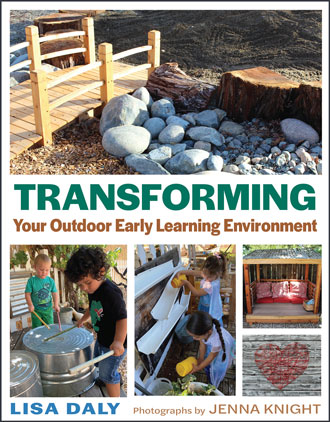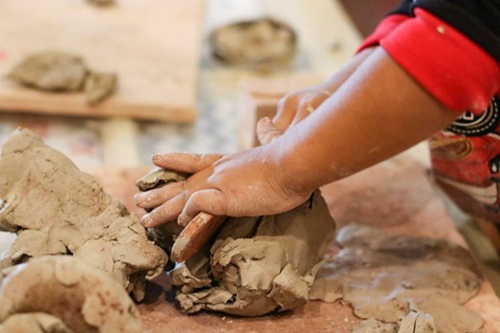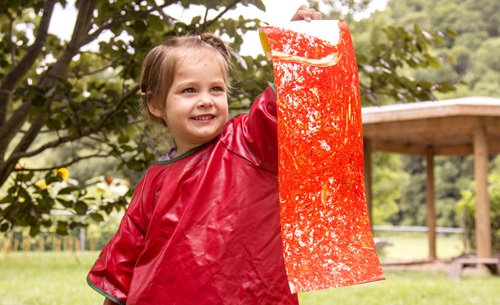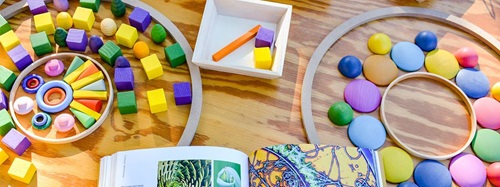Creating an Outdoor Art Studio
| June 2022An outdoor art studio is a functional, visually appealing, and inspirational space for children to do art outside. It is allows for art experiences such as drawing or painting with different media on a variety of surfaces and designing, modeling, or transforming materials in new ways. Doing art outdoors brings a whole new dimension to the creative process. The fresh air, fragrant smells, and sounds of nature stimulate your senses and nurture creativity. There is more freedom and less concern about mess. Children who may not venture into the indoor art area may be intrigued by outdoor art explorations.
The Value of Art Studios
Art is both a language and a process. Children’s feelings, thoughts, ideas, and reactions are communicated through doing art. Children’s language skills develop as they discuss materials, needs, explorations, and actions. When children engage with open-ended materials in an art studio, they explore and experiment, make decisions, solve problems, and develop concepts. Providing loose parts from the environment helps children interact more directly with their physical world and gain conceptual understandings.
Open-ended art fosters curiosity, flexibility, innovation, investigation, and resourcefulness. Art in an outdoor studio with loose parts enhances children’s creative expression, originality, and individuality. There is not a right or wrong way to create. When an art studio is filled with loose parts, children are in control of changing their ideas as they desire.
Using her creativity and problem-solving skills, Avril selected loose parts that reminded her of a turtle’s body parts. There was a canning lid body, keys for legs, a rectangular metal ring for the tail, and a metal snap hook for the head. Lastly, she placed small metal washers on top of the canning lid to represent the design on the turtle’s back. The metal pieces Avril selected have been used by other children to create castles, robots, suns, insects, helicopters, monsters, people, and more.
Because of the open-ended nature of loose parts, there are infinite creative possibilities. When an art studio is filled with loose parts, children are in control of changing their ideas as they desire.
Essential Components—What Every Art Studio Needs
Outdoor learning environments should be designed with the same intentionality as indoor learning environments. Just as when planning a room in your home, space planning, layout, use, and storage are critical. There is a difference between simply furnishing a play zone with materials and creating a space that offers functionality and identity. How do you envision children will use the space? Below are some important features to consider as you set up your outdoor art studio:
-
Space: Outdoor art studios work well on a patio, porch, or deck, especially with a cover that protects children on hot and rainy days so they may use the space almost all year long. Covers may include a pergola, gazebo, canopy, sunshade, or awning, which can be constructed or purchased at a big box retail store. Umbrellas may be adjusted or moved as needed to shield sun and rain. Art studios need to be inviting and beautiful. One way to enhance beauty is to surround the space with natural elements. Nestle the space next to trees, tall grasses, or bushes that provide variations in color and textures, or place plants in attractive ceramic pots nearby.
-
Workspace: When designing an art studio, start with functionality. Materials need to be available and easily accessible, and there must be different spaces for creating. A hard worksurface such as a tabletop is essential. For a group of 24 children, table space for six children is plenty, since not all children will be doing art at the same time. Consider setting up workspace on the ground for children who like to spread out or are unable to sit at a table. This could be a low wooden platform or smooth carpeted area. Low benches, inverted crates, or tree stumps make unexpected workspaces. Display intriguing loose parts on the work top to invite exploration.
Create defined work areas with picture frames, large tiles, placemats, wood cutting boards, wood trays, or acrylic mirrors. These objects provide a visually appealing look in addition to defining space. Strive for a minimum surface size of 12" x 12" to accommodate children’s creations. Place these work areas around the tabletop’s perimeter, one frame in front of each chair. Note that children may create their own boundaries and place materials on top of, around, or inside designated workspaces.
For painting, an easel is a valuable investment. Standing at an easel to paint or draw provides whole arm and total body movement. It is a different physical experience than painting or drawing while seated. A vertical mounted easel takes less space and can accommodate more children if made large. Easels can be handmade by a skilled volunteer and attached to a fence or building. Mount the easel so the easel paper is in front of the child’s chest; for toddler and preschool the bottom of the easel is usually 18” to 24” off the ground. A generous size of 3’ x 6’ allows three to four children to paint alongside each other. Mount a paint tray at the easel’s bottom to hold paint cups and catch drips or set a small table nearby to hold paint containers. Include clips for children to put up and take down their own paintings, and stretch a clothesline with clothespins near the easel for drying.
-
Enhancing Art Studios: A sustainable art studio is full of rich natural and manufactured materials that please your senses. Carefully select loose parts that are appealing to your visual sense (items of various forms, color, and size such as discolored wood); tactile sense (pokey sycamore balls, smooth bark); olfactory sense (rosemary, pinecones); baric sense (pieces of heavy tree branches, stones); and auditory sense (metal rings, pieces of chain). Additional elements such as windchimes, mobiles, metal wall décor, bamboo wall paneling, pottery, sculptures, and plants can provide inspiration and beauty.
|
Top Tips for Designing Art Studios
|
Storage and Organization
Materials for an outdoor studio are intended to stay outside to save time and energy bringing materials in and out. Convenient storage and organization are necessary. Heavy-duty shelves or secure and stable bench tops can display materials. Three- or four-tier shelf organizers provide storage space. Purchase shelving or construct them by securing thick, wide planks of solid wood on concrete blocks or tree trunks.
Organize items in shallow containers and on shelving units to keep the workspace ordered, clutter free, and clean. This helps children find items easily and make selections independently. Consider containers that can stand up to outdoor weather such as metal baskets. Wicker baskets will hold up for a season or two if kept under cover. Containers with sections are particularly good for displaying materials.
Arrange loose parts by categories such as color, material, or shape. For instance, place all items together that are blue or metal, or make a collection of items that are all round. Display materials in a container that has a similar property: circular materials in a round container or metal items in a metal one. Set up an invitation to explore familiar items by attractively placing materials on a tabletop. A wooden bowl or basket with compartments enhances natural materials of pinecones, tree cookies, seashells, and sea glass.
Standard mark making materials extend exploration possibilities. These materials can be stored in cans, bamboo boxes, or containers with sections. If children ask for glue, explain that sustainable artwork is temporary and lasts for a short time. It is all about placing materials in a thoughtful way. If a child asks to take their art creation home, talk about being able to reuse the beautiful materials, and take a photo of their work.
In a sustainable art space most explorations are done with loose parts, so water access isn’t usually needed for clean-up unless children are painting.
Cleaning and Maintaining the Space
Predictability is important for children, so keep art materials organized and in consistent spaces in the studio. Too many material options can be overwhelming, so be selective. Children can be guided to return materials and clean up when they are finished. Loose parts need to be sorted and returned to designated containers. Children are especially good at helping with classification. Rotate or add new items when children’s interest seems to be waning. For example, change out plastic bottle caps for tiles or add cinnamon sticks to natural materials. Sometimes new elements spark renewed interest. Be certain to check daily for broken pieces and safety hazards. Consumable materials such as markers or chalk need to be replenished when depleted. At the easel, children can independently get paint and clean up when finished. Provide a tub of water nearby for children to place their used brushes and containers. These materials will need to be washed daily. Paint on an art easel can stay. A paint-covered easel adds to the studio’s aesthetics. Other daily tasks include disinfecting tabletops and blowing or sweeping floor surfaces.
Creating space, time, and resources outdoors for children to engage in art is one of the best ways to encourage and foster children’s creative expression. Consider ways to offer drawing, painting, designing, and sculpting experiences in an outdoor art studio as the smells, sights, and sounds of nature offer inspiration and aid in creativity and innovation.
Transforming Your Outdoor Learning Environment published by Redleaf Press.
Copyright 2022 by Lisa Daly. Reprinted with permission from the author.













